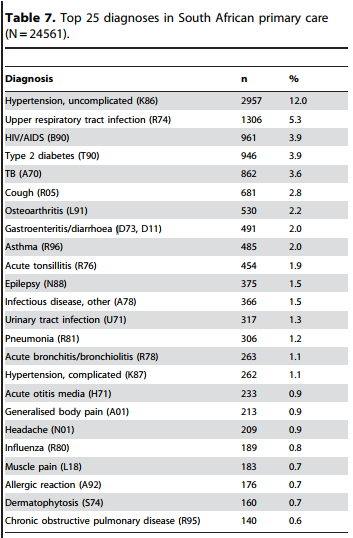
Common Symptoms
In a country where up to 70% (other sources quote 80%) of people rely on public clinics and hospitals, is there still a need for private doctors/GPs/general practitioners? With long waiting lines, a bad public health reputation, medication shortages and other long-standing problems, some are compelled to visit private doctors as an alternative. You can understand that for most cash-paying patients, expectations will be very high. Value for money from the economic point of view. If there is an overlap of public and private patients seeking GPs for greener pasture, it certainly means you can expect common presenting problems or symptoms.
GPs should be clued up with more than just western or urban pathology. Some conditions may be considered rare in developed countries or urban settings of South Africa.
For reference/perspective purpose, here are some of the common symptoms from a Canadian Practice:
Cough, sore throat, colds, abdominal/pelvic pain, rash, fever/chills, earache, back problem, skin inflammation and chest pain.
Common symptoms in British practice:
Cough, rash, sore throat, abdominal pains, bowel symptoms, chest pain, back pain, spots sores or ulcers, headache and joint pain.
The above top 10 symptoms were listed in the 70’s! Odd enough, they are still common symptoms in SA as well.
In a rural Kwazulu Natal practice (during 2006), the following presentations were at the top:
Administration, fever/chills, cough, wheezing, diarrhoea, feeling weak, headache, sore throat, abdominal pain and runny nose.
The administration part involved paper work needed. These included: chronic
medication application, medicals for insurance, professional driver permits and pre-placement medical examinations, blood test results, blood tests for general check ups, death certification and cremation medical forms, repeat scripts, extracts from clinical records, extension of sick leaves and injury on duty reports
Conditions Managed
Sometimes, symptoms do not always correlate closely to a system. For example, a cough does not always mean that one has a problem in the respiratory system. In the case of a cough however the respiratory system would be the commonly affected system.
Below is a list of commonly treated conditions in the US (review by Mayo Clinic) between 2005 and 2009:
- Skin disorders
- Osteoarthritis and joint disorders
- Back problems
- Cholesterol problems
- Upper respiratory conditions, excluding asthma
- Anxiety, depression, and bipolar disorder
- Chronic neurologic disorders
- High blood pressure
- Headaches and migraines
- Diabetes.
Compare to a list from Australia (2005 to 2010):
- Hypertension
- Immunisation
- Acute respiratory tract infection
- Depression
- Diabetes
- Lipid disorders
- General check-up
- Osteoarthritis
- Back complaint
- Prescription
Our South African profile from 2006 by NDTI (The National Disease and Therapeutic Index of South Africa):
- Hypertension
- Diarrhoea
- Acute respiratory tract infection
- Bronchitis
- Follow up examination after surgery
- Flu
- Chronic sinusitis
- Depressive episode
- Urinary tract infection
- Acute tonsillitis
- Supervision of normal pregnancy
- Diabetes
- Acute pharyngitis
- Otitis Media
- Dorsalgia (muscle, nerve or bone pain originating from the back)
- High cholesterol
- Abdominal pain
- Asthma
- Gastritis
Primary Care Level
Here’s a list from the clinics around the country
Symptoms:

Diagnoses:

The Verdict
Lifestyle diseases (hypertension, diabetes) are seen both in urban and rural settings. Arthritis, respiratory infections, asthma and flu are also common, globally. Public and private consults all seem to share a similar burden. There is a category of infectious diseases however appearing in the top 10 primary care (public) list: HIV and TB.
